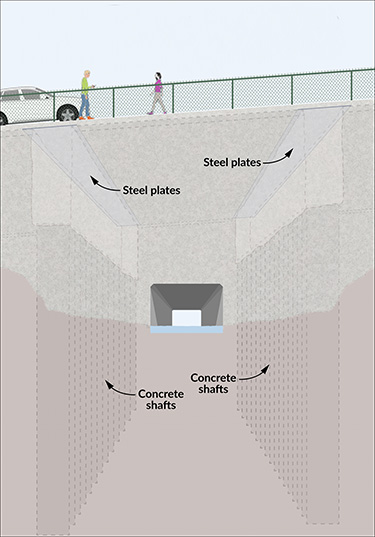|
Subscribe / Renew |
|
|
Contact Us |
|
| ► Subscribe to our Free Weekly Newsletter | |
| home | Welcome, sign in or click here to subscribe. | login |
Construction
| |
November 18, 2016
New WSDOT bridge will be out of sight
Journal Construction Editor
What do you do when you need to replace a fish-choking culvert below a busy highway, but can't close the road for more than a weekend?
Engineers from the Washington State Department of Transportation faced that dilemma with state Route 202 in Woodinville, and came up with an unusual solution: build a buried bridge.
“The concept is not new, but it has not been done very often,” said Tim Nau, assistant project engineer at WSDOT.
A typical culvert replacement would involve digging up the old culvert and installing a larger one. The problem with SR 202 is it's seven lanes wide and Little Bear Creek runs through the old culvert 30 feet below the elevated road.
WSDOT estimates the road would have to be closed for a month if they used the traditional replacement method, but only for a weekend — plus a few nighttime lane closures — if they go with a buried bridge.
So how do you build a buried bridge?
Olson Brothers Excavating, the project contractor, initially removed pavement and soil from behind the concrete retaining wall that supports the road. Crews installed steel plates over the road to cover the work and will soon start to drill shafts at night.
Two rows of 35 concrete shafts will reach 60 feet into the ground to form the abutment walls for the future bridge.
During the weekend closure, crews will dig down to expose the tops of the bridge supports and caps on the shafts, then drop in a series of concrete girders to span the two underground walls. About 7 feet of fill will be placed above the girders and then the highway will be repaved.
Nau said the weekend closure is projected for mid- to late March.
After the road is buttoned up, crews will break through the old retaining wall below, and excavate soil and the old culvert to expose the buried columns and bottoms of the girders.
The rows of columns will get additional concrete to create smooth interior walls for the new bridge and stream channel.
Part of Olson's nearly $5 million contract required the Puyallup-based contractor to relocate some water lines and underground power lines.
Nau said the buried bridge should be finished in fall 2017, a little longer than it would have taken using the traditional way. He said it also is somewhat more expensive, at about $7.5 million, but the impact on motorists will be significantly less.
The new opening for the creek will be 25 feet tall and 30 feet wide. The old culvert was 6 feet tall and 10 feet wide.
In addition to creating a better wildlife habitat, the new creek channel is expected to reduce flooding at a nearby intersection.
Benjamin Minnick can be
reached by email or by phone
at (206) 622-8272.



